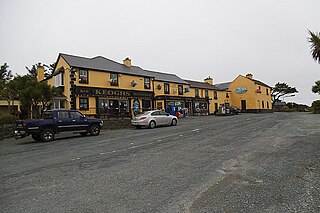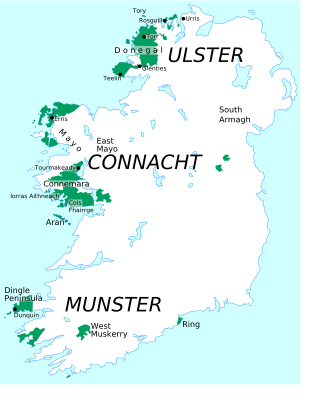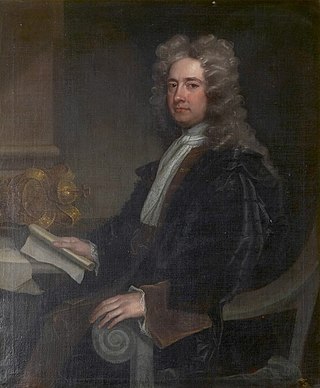
Ó Conghalaigh is a Gaelic-Irish surname. It derives from the forename Conghal, meaning "fierce as a hound". It is often anglicised as Connolly, Connally, Connelly and occasionally as Conley. In modern Irish it may be spelled as Ó Conghaile .

Ó Conghalaigh is a Gaelic-Irish surname. It derives from the forename Conghal, meaning "fierce as a hound". It is often anglicised as Connolly, Connally, Connelly and occasionally as Conley. In modern Irish it may be spelled as Ó Conghaile .
A number of distinct and unrelated families bore the surname in Gaelic Ireland, and with a number of spelling variants. They included:
In 1890 the surname was the twenty-third most common in Ireland, with three hundred and eighty-one births of the name, mostly in Ulster. By 1996, the ranking had slipped to thirty-third.
The variant Conneely was found exclusively in Connacht in 1890, with most occurrences in County Galway, giving Ballyconneely its name.
The Ó Conghalaighs of Airgíalla were either a branch of the Southern Uí Néill who removed to Airgíalla, or a branch of the Mac Mathghamna, kings of Airgíalla from the mid-13th century to 1590.
John Grenham says of them "They are first noted as coming to prominence in the fifteenth century and are recorded as having "Chiefs of the Name" up to the 17th century. They were instrumental in organising the native Irish Rebellion of 1641 and, following its failure, lost their power and possessions." Descendants of this family included William Conolly (1662–1729), James Connolly (1870–1916) and Paudge Connolly (born 1953).
Descendants of the Ó Conghalaigh of Iar Connacht include TG4 presenter Eibhlín Ní Chonghaile; musicians John Conneely and Johnny Óg Connolly; sportspersons Aislinn Connolly, Joe Connolly, Michael Conneely and Seamus Conneely; Mayors of Galway Catherine Connolly, Martin Connolly and Pádraig Conneely; scribe Micheál Ó Conghaile; writers Micheál Ó Conghaile (writer) and Seán Ó Conghaile.

Connacht or Connaught, is one of the four provinces of Ireland, in the west of Ireland. Until the ninth century it consisted of several independent major Gaelic kingdoms.
There are four provinces of Ireland: Connacht, Leinster, Munster and Ulster. The Irish word for this territorial division, cúige, meaning "fifth part", suggests that there were once five, and at times Meath has been considered to be the fifth province. In the medieval period, however, there were often more than five. The number of provinces and their delimitation fluctuated until 1610, when they were permanently set by the English administration of James I. The provinces of Ireland no longer serve administrative or political purposes but function as historical and cultural entities.
Conley from O′Conghaile or Ó Conghalaigh is a surname of Irish or Manx origin. The anglicized forms Conneely, Connealy, and Cunneely emerged due to the loss of the "gh" sound, which lengthened the second syllable of Conghal. In Connacht, these forms are often shortened from McNeilly, derived from Mac Conghaile. Another possible origin is the West Cork name Mac Coingheallaigh or Ó Coingheallaigh, meaning "faithful to pledges." Historically, O'Connolly was a principal name of County Monaghan.

Connemara is a region on the Atlantic coast of western County Galway, in the west of Ireland. The area has a strong association with traditional Irish culture and contains much of the Connacht Irish-speaking Gaeltacht, which is a key part of the identity of the region and is the largest Gaeltacht in the country. Historically, Connemara was part of the territory of Iar Connacht. Geographically, it has many mountains, peninsulas, coves, islands and small lakes. Connemara National Park is in the northwest. It is mostly rural and its largest settlement is Clifden.

West Connacht was a kingdom of Gaelic Ireland, associated geographically with present-day County Galway, particularly the area known more commonly today as Connemara. The kingdom represented the core homeland of the Connachta's Uí Briúin Seóla kindred and although they ruled, there were smaller groups of other Gaels in the area, such as the Delbhna Tir Dha Locha and the Conmhaícne Mara. It existed from 1051 onwards, after the Ó Conchobhair, Kings of Connacht, pushed the Ó Flaithbheartaigh to the West of Lough Corrib, from their original territory of Maigh Seóla. Iar Connacht remained a subordinate túath of Connacht, until the 13th century, after which it was more independent.
Heaney is a surname of Irish origin. It is an Anglicisation of the Gaelic Ó hEignigh, thought to be based on the Gaelic Eochaidh a personal name meaning "horseman". It was mistakenly thought to derive from Éan, Gaelic for Bird. Versions of it are written in the Annals from the 8th century and has a diverse array of modern derivations and origins.

O'Flaherty is an Irish Gaelic clan based most prominently in what is today County Galway. The clan name originated in the 10th century as a derivative of its founder Flaithbheartach mac Eimhin. They descend in the paternal line from the Connachta's Uí Briúin Seóla. They were originally kings of Maigh Seóla and Muintir Murchada and as members of the Uí Briúin were kinsmen of the Ó Conchubhair and Mac Diarmada amongst others. After their king Cathal mac Tigernán lost out to Áed in Gai Bernaig in the 11th century, the family were pushed further west to Iar Connacht, a territory associated with Connemara today. They continued to rule this land until the 16th century. The name has been alternatively rendered into English in various forms, such as Flaherty, Fluharty, Faherty, Laverty, Flaverty, Lahiff, Lafferty and Flahive.

Ballyconneely is a village and small ribbon development in west Connemara, County Galway Ireland.

Inverin is a Gaeltacht village between Baile na hAbhann and Minna in County Galway, Ireland. There are Irish-language summer colleges in the area, most notably Coláiste Lurgan and Coláiste Uí Chadhain.

Connacht Irish is the dialect of the Irish language spoken in the province of Connacht. Gaeltacht regions in Connacht are found in Counties Mayo and Galway. Connacht Irish is also spoken in the Meath Gealtacht Ráth Chairn and Baile Ghib. The dialects of Irish in Connacht are extremely diverse, with the pronunciation, forms and lexicon being different even within each county.

William Conolly, also known as Speaker Conolly, was an Irish Whig politician, Commissioner of Revenue, lawyer and landowner. He was an influential figure in Irish politics, serving as Speaker of the Irish House of Commons between 1715 and his death.
The Three Collas were, according to medieval Irish legend and historical tradition, the fourth-century sons of Eochaid Doimlén, son of Cairbre Lifechair. Their names were: Cairell Colla Uais; Muiredach Colla Fo Chrí ; and Áed Colla Menn. Colla Uais ruled as High King of Ireland for four years. Recent DNA analysis confirms the history of the Three Collas in fourth-century Ireland, but questions their descent from Eochaid Doimlén and Cairbre Lifechair.

Airgíalla was a medieval Irish over-kingdom and the collective name for the confederation of tribes that formed it. The confederation consisted of nine minor kingdoms, all independent of each other but paying nominal suzerainty to an overking, usually from the most powerful dynasty. Airgíalla at its peak roughly matched the modern dioceses of Armagh and Clogher, spanning parts of counties Armagh, Monaghan, Louth, Fermanagh, Tyrone and Londonderry. Its main towns were Armagh and Clogher. The name's usage survives as a cultural area of folk tradition in South East Ulster and adjoining areas of County Louth.
The surname Monaghan is a family name originating from the province of Connacht in Ireland. Mostly a last name.
Conneely, from or, is an Irish family name. Frequent examples of the name can be found in the West of Ireland, particularly in the Connemara area of County Galway. A coastal village in County Galway is named Ballyconneely.

Historically, Fermanagh, as opposed to the modern County Fermanagh, was a kingdom of Gaelic Ireland, associated geographically with present-day County Fermanagh. Fir Manach originally referred to a distinct kin group of alleged Laigin origins. The kingdom of Fermanagh was formed in the 10th century, out of the larger kingdom of Uí Chremthainn, which was part of the overkingdom of Airgíalla. By the late 11th century it had grown to cover all of what is now County Fermanagh. The kingdom came to be ruled by the Mag Uidhir (Maguire) clan from the late 13th century onward. They were based at Lisnaskea, and their royal inauguration site was nearby Sgiath Gabhra (Skeagoura), now called Cornashee. Under Hugh Maguire, Fermanagh was involved in the Nine Years' War against English rule. His successor, Cú Chonnacht Óg Mag Uidhir, was one of the Gaelic Irish leaders who fled Ireland during the Flight of the Earls. Fermanagh was subsequently merged into the Kingdom of Ireland as County Fermanagh.
The McPhillips surname may be of Scottish or Irish origin, the surname is found predominantly in Ireland, in Cavan, Fermanagh and Monaghan counties. It is usually derived from the common surname Phillips.
Ó Conghaile is an Irish name. Notable people with the name include: